
30 practical experience notes for making a stamping die work
This article talks about the 30 notes for the design and production of making a stamping die and the experience in practical making a stamping die work. Here we go!
Making a stamping die note 1
Before planning the strip, it is important to understand the public service requirements of the part, the material properties, the tonnage of the press, the press table, the SPM (strokes per minute), the feeding direction, the feeding height, the die thickness requirements, the material utilization rate, and the die life.
Making a stamping die note 2
When planning the strip, CAE analysis should be carried out together with the primary consideration of the material thinning rate, which is generally below 25%.
Special deep drawing stainless steel material, can be in the pre-stretching and then annealing, with high-frequency annealing machine, the thinning rate can be accepted to 40%, in the regulation is very important.
In the mold length answer scratch material belt, must and the customer more communication, the best to ask the customer to supply the previous mold photos or structure diagram to refer to, the empty step should also be the case, appropriate leave empty step on the test mold after the change of mold assistance is great.
Making a stamping die note 3
Material belt planning is the analysis of the product forming process, which basically determines whether the mold is successful or not.
Making a stamping die note 4
In continuous mold planning, it is very important to plan the lifting of the material. If the lifting bar does not lift the entire material belt, it will not be possible to automate continuous production.
Making a stamping die note 5
In die mold planning, the selection and heat treatment of the mold material and the external treatment (e.g. TD, TICN, TD time is 3-4 days), especially for tensioned parts, without TD the mold surface will be easily burnt and hairy.
Making a stamping die note 6
In the mold planning, on the hole position or public service requirements of the smaller surface, as far as possible to do adjustable inserts, easy to adjust in the test mold and production, in order to simply reach, the scale of the part requirements, to do adjustable inserts when the upper and lower mold together.
On the wordmark, the requirements in the punching machine can be removed, do not need to be removed again under the die, and waste time.
Making a stamping die note 7
When planning the hydrogen bandage spring, according to the CAE analysis of the pressure to plan, do not plan too large a hydrogen bandage spring, to prevent the product from cracking. The general situation is small pressure, product wrinkling, large pressure, product cracking.
To deal with the wrinkling of the product, you can use the method of partially adding a stretching bar, first using the stretching bar to fix the bit of sheet material, and then stretching to reduce wrinkling.
Making a stamping die note 8
When testing the mold for the first time, the upper mold must be closed slowly, and when there is a stretching process, the thickness of the material must be tested with a fuse, and the gap between the material and the thickness of the material must be reached before testing the mold, and the knife must be aligned first. Please use movable inserts to adjust the height of the stretching bar.
Making a stamping die note 9
Mold-fitting red paint must be well-matched, the fit rate reaches 80% or more before you can open the cutout and do the CMM report, or perhaps the reference hole reference surface has been matched, the product has been very stable and dense, the fit rate can be properly reduced.
The mold-fitting red paint is a very important element, otherwise, the product is not stable, cannot be late to change the mold judgment, the scale of the parts will not meet customer requirements.
Making a stamping die note 10
Customer sample office requirements: Generally first laser office → shear mouth office → 100% OK.
In the laser office stage to match the mold-fitting red paint, feed material adjustment, deal with cracking wrinkles, scale public service problems, in the open shear mouth office basically change the primary problem, the latter is fine-tuning (mold local improvement).
Making a stamping die note 11
When testing the mold, the reference hole, the reference surface must be molded and then put the product on the inspection tool to measure, or send to CMM to do a 3D report, otherwise, it is meaningless.
Making a stamping die note 12
In the case that the customer must cut the mouth of the office but the process conditions are not mature, we can consider opening a soft material cutter (that is, directly with 45 steel open cutter, change the cutter directly burned, and then open the official hard material cutter after the scale OK).
Making a stamping die note 13
For 3D messy products, you can choose the 3D laser method to laser, before 3D laser must do a good job of 3D graphics, with CNC playing a good reference point position and then sent to 3D laser, the 3D laser also does positioning sand type.
Making a stamping die note 14
For high-strength steel plates, carbide materials such as A88 or V4 should be used for the cutting edge.
Making a stamping die note 15
In the test mold, in order to test the tensile role, can be in the material on different positions on the pad sandpaper to test the role, to determine the role in the corresponding position in the activity of the stretching bar or the activity of the pockmark array (is a piece of plating grinding into the pockmark), used to play the abrasion hindrance go material.
Making a stamping die note 16
Bending more parts, adjust the mold according to the process step by step to adjust the bending.
Making a stamping die note 17
When adjusting the forming point of view, you can close the small bending R angle or move the folding line benchmark to complete the purpose of reaching the forming point of view.
Making a stamping die note 18
Most of the shims are used to adjust the height of the forming male or to move the forming male from side to side, and the shims are generally made of hard stainless steel. (If the customer forbids the use of shims, the mold is adjusted and then a new workpiece is made for the customer).
Making a stamping die note 19
For molded parts made of stainless steel, TD cannot be used, but TICN or PVD should be used.
Making a stamping die note 20
It is important to determine when the customer’s official material will arrive so that the material can be used sparingly during the test molds and to prevent the occurrence of insufficient material.
Making a stamping die note 21
There are two types of sensors for continuous molds, one is a step sensor and the other is a drop sensor.
Making a stamping die note 22
The scrap hopper has a slope of at least 30 degrees and the low point of the scrap box can be dealt with by installing a pneumatic vibration device.
Making a stamping die note 23
The cut edge line, which is affected by the forming, should be selected after the forming, and the special position can be completed by the cross-cutting method.
Making a stamping die note 24
In the case of multiple reference holes, it is best to use a single punching process to prevent step-by-step punching from affecting accuracy.
Making a stamping die note 25
Regarding the analysis of the test mold, it is necessary to analyze the material strip after the test mold, step by step, and to attach the mold-fitting red paint material strip.
Making a stamping die note 26
For product breakage, a variety of methods can be adopted, such as adding packs, squeezing, increasing the forming area of the sheet, opening holes, etc., during the pre-stretching period, and CAE analysis should be carried out before the mold change.
Making a stamping die note 27
The product material is divided into two kinds of coil material coil and sheet material sheet, some coil material to the factory after the need to re-slit to the width of the material strip. Generally, in the slit scale for negative metric service (negative 0.5mm), and coil material inside diameter to fit the scale of the feeding frame, to prevent too big or too small and too heavy.
Making a stamping die note 28
When the stamping die mold is processed, the pinhole of the line cut is generally used as the base for the number of touches, and the CNC is programmed to require the operator to give the coordinates of the two holes to the programmer, who will seek the point of view and then process the program after a point of view. Generally, when machining the template for the first time, it is not necessary to find a point of view for the edge machining.
Making a stamping die note 29
The concept of fine blanking is to leave no blanking gap (or only 0.5%). Generally, the blanking gap is 10% of the thickness of the material, the thicker the material, the larger the gap share.
Making a stamping die note 30
Hardware samples that do not meet the scale requirements can be completed by shaping, including plum pile, flattening again, simple punching, and so on to repair the phi front.
The above is a summary of some of the experience in practical stamping die work, and I hope it will help those who read this article to improve the die pass rate and reduce the number of die mold trials.
Besides this article, you may also be interested in the below articles.
Summary Of 50 Injection Mold Structure Operation Dynamic Diagrams
Auto Parts Stamping Die Design Concept




